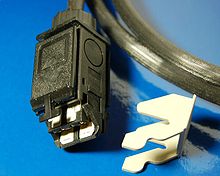IBM cabling system
The IBM cabling system (IVS) (English. IBM Cabling System (ICS) ) refers to a specification of the company IBM for cables, plugs, patch panels and other passive cabling elements.
history
In the early days of EDP, the most diverse, mostly proprietary (in-house) data cables were in use for the various computer systems , and they were incompatible with one another. These cables had a different structure (coaxial, twinaxial, twisted), different connectors (BNC, N-type, DB) and different impedances (50 ohms, 93 ohms, 100 ohms, 105 ohms). When IBM developed the token ring network in the 1980s , new cable types were also developed in parallel.
The core of the IVS was a two -pair twisted pair cable and a hermaphroditic connector, the so-called IBM connector or IVS connector according to IEEE 802.5. While the plug, which was both a plug and a socket, i.e. could be plugged into itself, was intended for all parts of the fixed cabling, the " Token-Ring " terminals had a nine-pin DB socket.
Cable types
In the IVS, the cables have been grouped under "types". The most common types in Europe were 1 and 6:
- Type 1
STP (Shielded Twisted Pair), 2 wire pairs 22 AWG solid, 150 Ohm, 16 MHz; Installation cable
- Type 2
corresponds to type 1 with 4 additional wires for telephone lines
- Type 3
UTP, 100 ohms
- Type 5 & 5J
Fiber optic cable
- Type 6
STP, 2 wire pairs 26 AWG stranded wire, 150 Ohm, 16 MHz; Patch cord
- Type 8
Flat installation cable
- Type 9
STP, 2 wire pairs 26 AWG stranded wire, 150 Ohm, 16 MHz; Terminal device connection cable
Extended
The extended STP-A cabling for frequencies up to 300 MHz was specified in the TIA / EIA 568-A standard.
- Type 1A
- Type 2A
- Type 6A
- Type 9A
meaning
The specification was later expanded and various cable types received an "A" (for example "IBM Type 1A") as a sign that they are approved for an extended frequency range up to 300 MHz.
The intention behind the IVS was not only to develop a cable for the token ring , rather a universal cabling system was to be designed with which all previously common IBM devices can be connected via a standardized building cabling. For this purpose, a number of adapter plugs, so-called baluns , have been added to the IVS . Baluns are not just pure mechanical converters of the various connector types, but above all adapt the impedance so that there are no disruptive wave reflections at the interface between the two cable types.
In this way, for example, a 3270 terminal device, which has a BNC connector for an RG-62 coaxial cable , could be connected to its control unit via building cabling with IVS plugs - provided there is a corresponding one at each end of the IVS cable route Balun .
literature
- IBM Document GA27-3773, 1984 IBM Corp.
- TIA / EIA 568-A standard
